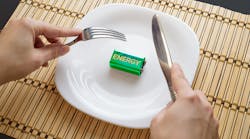Looking for a snack? Try a rechargeable, edible battery
Over the past few years, my cooking skills have increased exponentially, thanks in no small part to pandemic-induced isolation and an ‘if not now, when’ mentality. I used to dismiss recipes if they utilized more than five ingredients or required more than one pan. Now I actively seek out recipes that will require more time, challenge my skills, or force me to buy that useless kitchen gadget that I’ve been thinking about ever since I saw it on TikTok. On my culinary journey, I’ve cooked everything from ribs and roasts to soups and stews, American-made favorites to around-the-world cuisine. The one thing I’ve never considered cooking, however, is a battery. Yes, you heard me right. Edible, food-based batteries are now a reality.
Researchers from Istituto Italiano di Tecnologia (IIT) have used products found in many pantries to develop a rechargeable, edible battery. In a release from IIT, the team outlines how they constructed the battery: “The IIT’s research group took inspiration from the biochemical redox reactions that happens in all the living beings, and developed a battery that utilizes riboflavin (vitamin B2, found for example in almonds) as anode and quercetin (a food supplement and ingredient, present in capers, among others) as cathode. Activated charcoal (a widespread over-the-counter medication) was used to increase electrical conductivity, while the electrolyte was water-based. The separator, needed in every battery to avoid short circuits, was made from nori seaweed, the kind found in sushi. Then, electrodes were encapsulated in beeswax from which two food-grade gold contacts (the foil used by pastry chefs) on a cellulose derived support come out.”
The team, which includes, Ivan K. Ilic, Valerio Galli, Leonardo Lamanna, Pietro Cataldi, Lea Pasquale, Valerio F. Annese, Athanassia Athanassiou, and Mario Caironi, recently published their findings in the Advanced Materials journal. In an excerpt from the paper, the team wrote: “By encapsulating the electrodes in beeswax, a fully edible battery is fabricated capable of supplying power to small electronic devices. The proof-of-concept battery cell operated at 0.65 V, sustaining a current of 48 µA for 12 min.”
In a recent quote, Ivan Ilic, coauthor of the study, said, “This edible battery is also very interesting for energy storage community. Building safer batteries, without usage of toxic materials, is a challenge we face as battery demand soars. While our edible batteries won’t power electric cars, they are a proof that batteries can be made from safer materials than current Li-ion batteries. We believe they will inspire other scientists to build safer batteries for truly sustainable future.”
